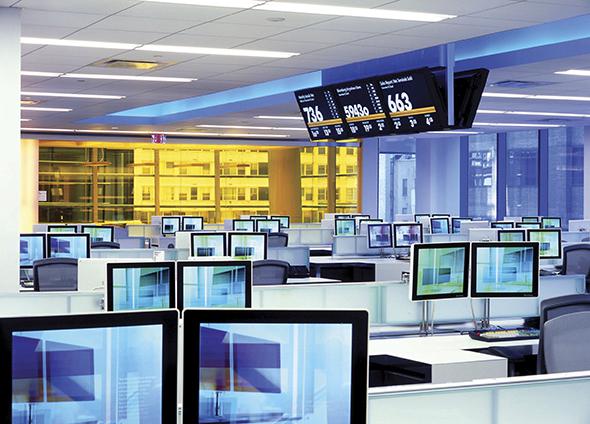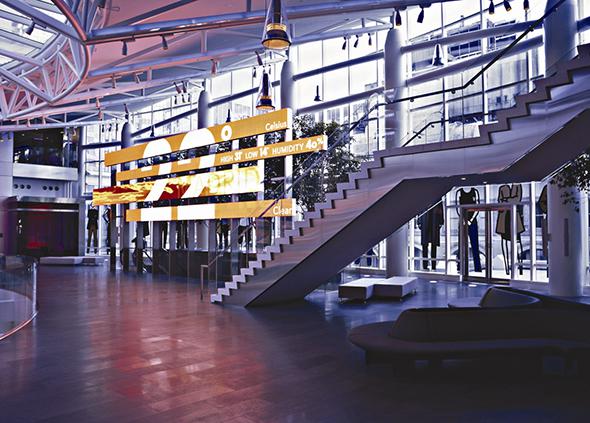When I first met Jack Dorsey, the billionaire co-founder of Twitter, he was working on his new project, Square—the post-Twitter venture he’d launched in an effort to disrupt the payments industry. I’d come to interview Dorsey for a magazine profile, and when I walked into Square’s San Francisco office space I immediately spotted him. He was impossible to miss. He worked standing up, typing on an iPad at a navel-high table in the dead center of the open-air floor plan.
When we imagine a powerful CEO, we typically picture a secluded corner office large enough to fly a kite in, with thick wood paneling, plush pile carpets, and a gatekeeping assistant—all designed to dampen the intrusion of any exterior stimuli. But a newer vision of management feng shui involves an emphasis on availability, transparency, and the abolishment of physical hierarchies. “My door’s always open,” that old, sometimes insincere invitation to underlings, somehow seems more deeply earnest when there isn’t any door at all.
“I’m much more accessible this way,” Dorsey told me of his setup. “People can come right up to me and ask me questions if they need to.” Dorsey’s not the only corporate leader to favor a vulnerable work posture. Observe, in this photo of the offices of the website Business Insider, CEO Henry Blodget mimicking Dorsey’s tall-tree-on-the-plains workstation style.
There are countless ways for managers to shape the psychological environments of their employees. Designing the physical workspace may be easy to overlook as a means of dictating corporate culture, but it is in some ways the most fundamental of management choices. The tenor of meetings, the ease of collaboration, and the frequency of serendipitous colleague interactions can all be deeply affected by the landscape of an office.

Square’s new offices in San Francisco embrace transparency in every sense of the word.
Photo courtesy Square
Bloomberg, the financial data and media company founded in 1982 by Michael Bloomberg, is a case study in the integration of corporate mission and corporate headquarters. Bloomberg’s lucrative proprietary finance software was launched with an eye toward creating more transparency in markets, and so the company’s offices are meant to elevate transparency as a goal. “Ours is an open plan layout,” Michael Bloomberg wrote in his 1997 book Bloomberg by Bloomberg. “As is true with markets, transparency produces fairness.”
To tour the Bloomberg offices in Midtown Manhattan—within a 2005 building designed by Cesar Pelli—is to witness the open plan aesthetic taken to its logical extreme.* Row upon row of workstations fan out along endless tables in massive atriums with nary a divider to break up the space. On the rare occasion when some sort of partition becomes necessary (for example, to delineate a conference room) the favored material is clear glass that may block noise but does not obscure vision.
Even top-level employees work out in the open. On a recent visit, Chairman Peter Grauer and CEO Daniel Doctoroff could be seen taking meetings in the conference rooms directly behind their desks. Any passerby could observe who had joined the meeting and how long they stayed, and if one were so inclined one could even assess body language clues to get a sense of how things were going. When at their desks, Grauer and Doctoroff are seated just off the main lobby area on the building’s sixth floor, easily accessible to anyone walking through.
That sixth-floor area—known as “the link”—is a purposeful means of creating forced interaction. Every Bloomberg employee and visitor is initially routed through this space (which coincidentally contains Bloomberg’s legendarily free and bounteous snack bar), before continuing on to a final destination. Whether you work on the fifth floor or the 23rd, you must first go to the sixth and catch an escalator or elevator from there. All workers great and small pass through the bustling environs of “the link,” and the many buzzy conversational clumps there attest to its effectiveness as a watering hole.
Even after making it to the sixth floor, taking an elevator may not be the end of your journey—or your face-to-face encounters. Those elevators don’t stop on every floor, which necessitates further gathering spaces as employees disembark before heading one or two more floors up or down. Employees at Bloomberg marvel at how often they randomly bump into each other throughout the day, making it easy to informally check in on projects and plans.

Photo courtesy Bloomberg
The purpose of all this engineered mingling? It encourages something that a Bloomberg spokesperson terms “institutional eavesdropping.” Employees get a sense of what’s going on in every part of the company—almost through osmosis. As Michael Bloomberg puts it in his book, workers “absorb information peripherally while focusing elsewhere.” And this fuller understanding of corporate doings seems to quell office paranoia. “Openness also constantly puts [employees] in front of their peers,” Bloomberg writes, “preventing childish fantasies that coworkers are out to get them.” (In case you’re wondering: The big man himself, when at the office, sits at an open desk on the fifth floor.)
“In a deadline business, where every bit of missed communication can have an impact on the final product,” says Josh Tyrangiel, editor of Bloomberg Businessweek, “open plan is pretty spectacular. It ensures that everyone is attuned to the broad mission, and … it encourages curiosity between people who work in different disciplines. So the art department and staff writers—who at most magazines are separated like lemurs and rhinos—end up mixing and lingering whenever they spot something of interest.”
“Most of the startups Bloomberg Beta invests in and works with have an open plan,” says Karin Klein, a partner at Beta, a Bloomberg venture fund that invests in early stage technology companies. “Interestingly, many startup founders, when they come to visit us, feel right at home. They are impressed with Bloomberg’s scale and ability to retain the openness and energy of a startup. And everything at Bloomberg is designed to keep that spirit.”
Of course, there are drawbacks to working in an open-plan office. Some employees may find it harder to concentrate when in close proximity to others’ chatter and phone conversations, and with no barriers to sudden visits from annoying, time-wasting colleagues. “People must develop the ability to concentrate,” writes Bloomberg, “despite myriad distractions.” Tyrangiel feels this isn’t an insurmountable challenge. “It’s surprising how fast people are able to tune out the incidental noise,” he says. “The only real downside is that some people have terrible taste in music.”
Some of the benefits of the open plan may be mildly oversold. For instance, that vaunted facilitation of spontaneous mingling. “Research shows,” according to an article in Time, “that while conversations are indeed frequent among employees in open offices, they tend to be short and superficial—precisely because there are so many other ears around to listen.” Sure, closed doors can foster mystery and paranoia, but they also enable sharing the juiciest gossip and the most forthright opinions. And indeed, even Bloomberg employees are known to seek out hidden corners away from prying ears and eyes when they need a bit of privacy. A Bloomberg spokesman swears the ubiquitous fish tanks around the office are merely an inducement to visual relaxation, but they might equally serve as a metaphor for the panopticonic aspects of the open plan scheme.
Why is the open plan so hot these days? As Klein notes, startup culture favors stripped down office spaces—partly because there’s only so much room to fit card tables in the proverbial Silicon Valley garage, and partly because startups grow and shrink at rapid speed, and flexibility is a must. Startups have cachet in today’s business world, so there’s a bit of a cool factor that comes into play when larger companies emulate the startup aesthetic.
But startups also run lean to cut costs. And one could argue that the true purpose of the open plan office is far more pedestrian than Michael Bloomberg suggests: It’s a terrific means of squeezing many more desks into much less space—and thus, saving money. The recent book Cubed: A Secret History of the Workplace, by Nikil Saval, suggests that every idealistically-minded office space innovation ultimately becomes another tool of economization: “[Companies] wanted to stuff as many people in as small a space for as cheaply as possible as quickly as possible.”
Still, the utopian appeal of the open plan—its ability to mold office culture—remains a siren call that entrepreneurs find hard to resist. Consider Tony Hsieh, the CEO of Zappos, who seems bent on turning all of downtown Las Vegas into an open-plan office writ large. Hsieh is working to fill the neighborhood with tech startups from diverse fields, along with new restaurants, a health clinic, and other cultural attractions and municipal improvements. His reasoning? As Mark Joseph Stern wrote in Slate, “Hsieh holds an almost romantic faith in a city’s ability to foster creativity through what he called ‘the 3 C’s’: collisions, co-learning, and connectedness.” As Hsieh told Slate, his project is all about “creating opportunities for people to work and play closer to one another.” Sounds a lot like Michael Bloomberg’s vision for his open-plan corporate HQ.
Correction, May 5, 2014: This piece originally misstated that the Bloomberg Offices in Midtown Manhattan are within a building designed by Cesar Pelli that was completed in 2006. The building was completed in 2005.
